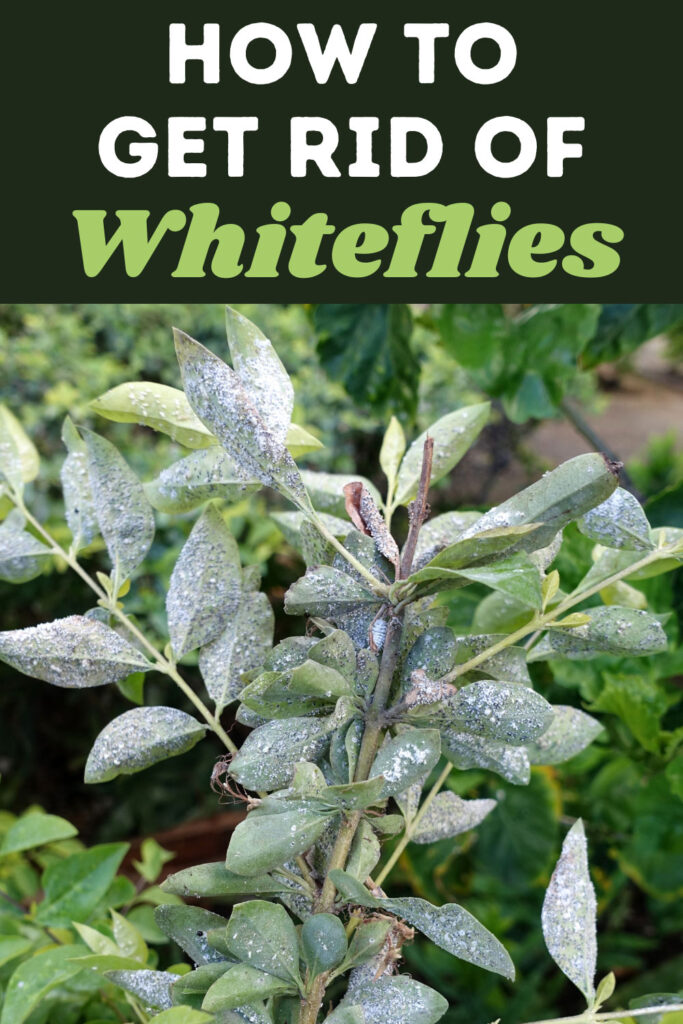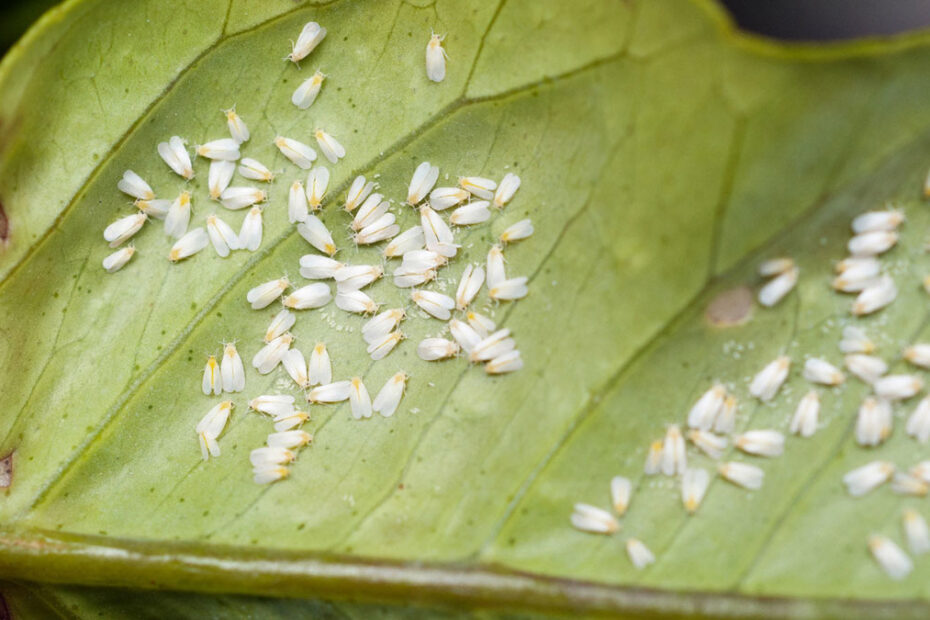Whiteflies might be tiny, but they can wreak havoc on your garden, turning lush green leaves into a yellow, wilting mess. These sap-sucking pests multiply quickly, making it essential to act fast before they take over. If you’re tired of seeing your plants suffer, it’s time to take control and reclaim your garden.
In this guide, you’ll discover effective strategies to eliminate whiteflies and prevent future infestations. From natural remedies to targeted treatments, we’ve got you covered. Say goodbye to these persistent pests and hello to a healthier, thriving garden.
Key Takeaways
- Identification: Recognize whiteflies by their tiny, white-winged appearance, honeydew secretion, yellowing leaves, and flight when disturbed.
- Affected Plants: Commonly invaded plants include tomatoes, peppers, ornamental plants, cucumbers, and popular houseplants.
- Natural Remedies: Employ beneficial insects like ladybugs and green lacewings, and use neem oil for eco-friendly whitefly control.
- Chemical Solutions: Apply insecticidal soaps and commercial pesticides such as neonicotinoids and pyrethroids for severe infestations.
- Preventative Measures: Regularly monitor plants, use yellow sticky traps, and maintain proper plant care to deter whiteflies and minimize infestations.

Understanding Whiteflies
Whiteflies are small, winged insects that inhabit various plants, leading to noticeable damage. They belong to the Aleyrodidae family and resemble tiny moths. You might often see them on the underside of leaves, where they feed and lay eggs.
Essential Characteristics:
- Appearance: Whiteflies typically measure around 1-2 millimeters. They possess a white, waxy coating that covers their wings and body.
- Lifecycle: Their lifecycle includes egg, nymph, and adult stages. The eggs hatch into nymphs, which are the stages most responsible for plant damage.
- Feeding Habits: They use their needle-like mouthparts to suck sap from plants, causing yellowing, wilting, and stunted growth in severe infestations.
Key Points To Note:
- Reproduction Rate: Whiteflies can reproduce quickly, with a single female laying up to 400 eggs. This rapid reproduction can lead to infestations in a short time.
- Affected Plants: Tomatoes, peppers, and ornamental plants are among the common targets. Look for signs of whitefly damage if you grow these plants.
- Spread: Wind can carry adult whiteflies to new areas. They can also hitch a ride on infested plants purchased from nurseries.
- Inspect Leaves: Check the underside of leaves for white, powdery insects. Look for a sticky substance called honeydew, which they excrete.
- Monitor Plant Health: Yellowing or wilting leaves can be early signs. Stunt growth might indicate their presence during peak infestation times.
- Use Yellow Sticky Traps: Place traps near suspect plants. Whiteflies are attracted to yellow and will adhere to the traps, confirming your suspicions.
Taking the time to understand whiteflies’ characteristics and behavior enables you to take effective measures. Knowledge of their lifecycle, affected plants, and identification methods forms the foundation of successful whitefly management.
Identifying Infestation
Whiteflies can cause significant damage to your garden if left unchecked. Identifying an infestation early helps prevent extensive harm.
Signs of Whiteflies
Identifying whiteflies is straightforward if you know what to look for:
- Tiny Insects: Look for small, white-winged insects around 1-2 millimeters on the undersides of leaves. Their white, waxy coating helps identify them.
- Honeydew: Check leaves for a sticky, shiny substance. This honeydew attracts sooty mold, causing leaves to look blackened.
- Yellowing Leaves: Monitor for yellowing, wilting leaves, which indicate sap removal by whiteflies.
- Flying Clouds: Disturbing the plant may cause a cloud of tiny white bugs to take flight.
These signs provide clear indicators of a whitefly presence in your garden.
Affected Plants
Some plants are more susceptible to whitefly infestations:
- Tomatoes: Frequently targeted due to their lush, dense foliage.
- Peppers: Both bell and hot peppers attract whiteflies.
- Ornamental Plants: Includes hibiscus, fuchsia, and jasmine.
- Cucumbers: Whiteflies often infest cucurbit vegetables.
- Houseplants: Popular indoor varieties like poinsettias and ferns are also at risk.
Identifying the specific plants affected can help tailor your treatment plan to effectively combat whitefly infestations.
Natural Remedies
Using natural remedies is an effective and eco-friendly way to get rid of whiteflies. Implementing these techniques can protect your plants without harmful chemicals.
Beneficial Insects
Introducing beneficial insects can naturally control whitefly populations by predation.
Key Beneficial Insects:
- Ladybugs: Ladybugs consume whitefly eggs and nymphs.
- Green Lacewings: Green lacewings target and feed on whitefly larvae.
- Parasitic Wasps: These wasps lay their eggs inside whitefly nymphs, effectively controlling them.
How to Attract Beneficial Insects:
- Plant nectar-rich flowers like marigolds and sunflowers.
- Avoid using broad-spectrum insecticides.
- Provide diverse plant species for habitat diversity.
Neem Oil
Neem oil is a natural insecticide derived from the neem tree, effective against whiteflies.
Application of Neem Oil:
- Preparation: Mix 2 tablespoons of neem oil and 1 teaspoon of mild soap into 1 gallon of water.
- Spraying: Apply the solution using a spray bottle, focusing on the undersides of leaves.
- Frequency: Reapply every 7 days until the whiteflies disappear.
- Non-Toxic: Safe for humans, pets, and beneficial insects.
- Systemic Effects: Disrupts whitefly growth and reproduction.
- Repellency: Acts as a feeding and egg-laying deterrent.
Using these natural remedies, you can effectively manage whitefly infestations while maintaining a healthy garden ecosystem.
Chemical Solutions
When natural remedies aren’t enough, chemical solutions can effectively control whitefly infestations.
Insecticidal Soaps
Insecticidal soaps offer an effective way to target whiteflies without harming plants. These soaps are made from potassium salts of fatty acids and work by breaking down the protective outer layer of insects.
Key Benefits:
- Non-toxic: Safe for humans and pets
- Low Residue: Minimal environmental impact
- Broad Spectrum: Effective against various soft-bodied insects
Application Steps:
- Mix Solution: Combine the insecticidal soap with water as instructed on the product label.
- Apply Directly: Spray the mixture on the underside of leaves where whiteflies are usually found.
- Repeat Treatment: Reapply every 7-10 days until the infestation is under control.
Commercial Pesticides
Commercial pesticides provide quick and potent solutions for severe whitefly infestations. These formulations are available in various chemical classes, ensuring effective management of resistant whitefly populations.
Types of Pesticides:
- Neonicotinoids: Systemic insecticides absorbed by plants, affecting whiteflies when they feed.
- Pyrethroids: Synthetic insecticides that disrupt the nervous systems of insects upon contact.
- Insect Growth Regulators (IGRs): Chemicals that interfere with the development of nymphs, preventing them from reaching adulthood.
- Select Appropriate Pesticide: Identify the most effective pesticide type for your infestation.
- Follow Label Instructions: Adhere to the manufacturer’s guidelines about dosage and application frequency.
- Protect Non-target Species: Use protective barriers or selective applications to avoid harming beneficial insects.
Applying these chemical solutions strategically can help maintain healthy plants and reduce whitefly populations effectively.
Preventative Measures
Implementing preventative measures is essential to keep whiteflies from infesting your garden. By being proactive, you can maintain healthy plants and avoid the hassle of dealing with a severe infestation.
Regular Monitoring
Regular monitoring helps identify whiteflies early. Check plants weekly, especially the undersides of leaves. Use yellow sticky traps to capture and monitor whitefly populations.
- Visual Inspections: Examine plants for whiteflies, nymphs, and honeydew.
- Sticky Traps: Place yellow sticky traps around the garden to catch adult whiteflies.
- Record Keeping: Maintain a log of inspection dates and findings.
Proper Plant Care
Proper plant care strengthens plants’ natural defenses, making them less attractive to whiteflies.
- Healthy Soil: Use well-draining soil enriched with compost to provide nutrients.
- Watering: Water plants adequately, keeping the soil moist but not waterlogged.
- Pruning: Remove dead or affected leaves regularly to prevent disease spread.
- Spacing: Ensure enough space between plants for air circulation.
Investing time in these preventative measures will help maintain a whitefly-free garden. Regular monitoring and proper plant care are essential for early detection and deterrence.
Conclusion
Effectively managing whiteflies requires a combination of quick action, natural remedies, and, when necessary, chemical solutions. By understanding their lifecycle and behaviors, you can tailor your approach to eliminate these pests and prevent future infestations. Regular monitoring and proper plant care are essential for maintaining a healthy, whitefly-free garden. With these strategies in place, you’ll protect your plants and enjoy a thriving outdoor space.
Frequently Asked Questions
What are whiteflies and how do they affect plants?
Whiteflies are small, winged insects about 1-2 millimeters long, covered with a white, waxy coating. They damage plants by sucking their sap, leading to yellowing and wilting of leaves, and can cause rapid infestations.
How can I identify a whitefly infestation?
Signs of a whitefly infestation include tiny white-winged insects on plants, sticky honeydew on leaves, yellowing and wilting foliage, and clouds of flying whiteflies when plants are disturbed.
Which plants are most susceptible to whitefly infestations?
Tomatoes, peppers, hibiscus, jasmine, cucumbers, poinsettias, and ferns are particularly susceptible to whitefly infestations.
What natural remedies can I use to control whiteflies?
Introduced beneficial insects like ladybugs and green lacewings can naturally control whiteflies. Neem oil is also effective as a non-toxic insecticide that disrupts whitefly growth and reproduction.
What chemical solutions are effective against whiteflies?
Insecticidal soaps, neonicotinoids, pyrethroids, and insect growth regulators (IGRs) are effective chemical solutions. These should be applied strategically to protect non-target species.
How can I prevent whitefly infestations in my garden?
Regular monitoring, using yellow sticky traps, and maintaining plant health with proper soil, watering, pruning, and spacing are critical preventative measures to avoid whitefly infestations.
